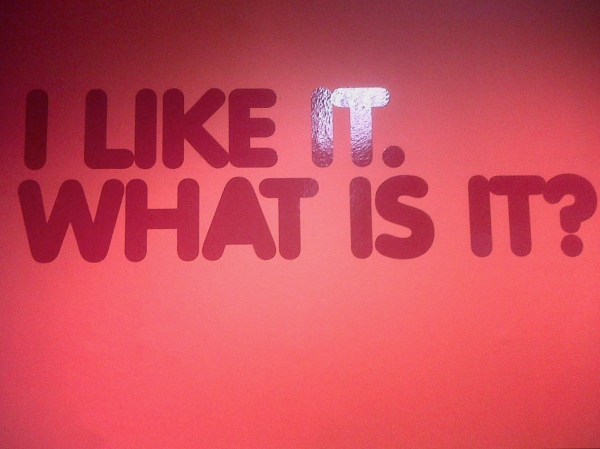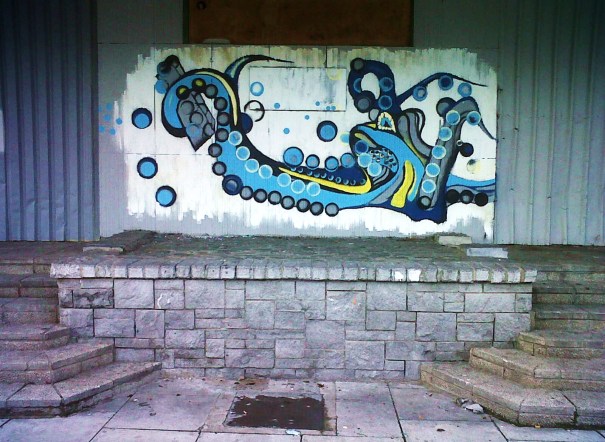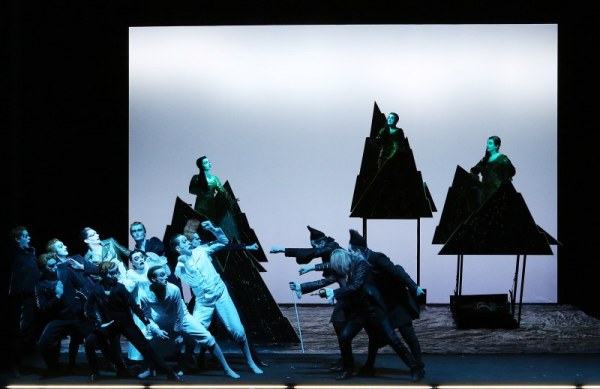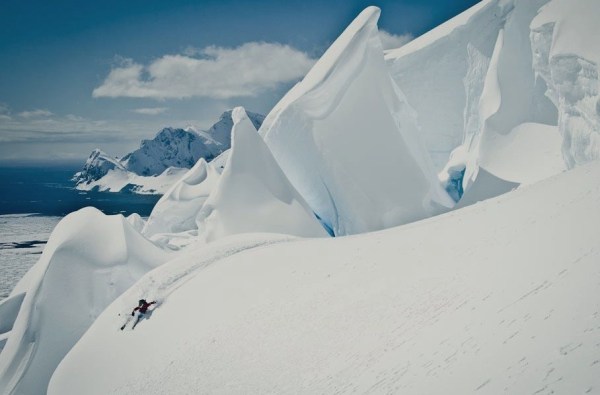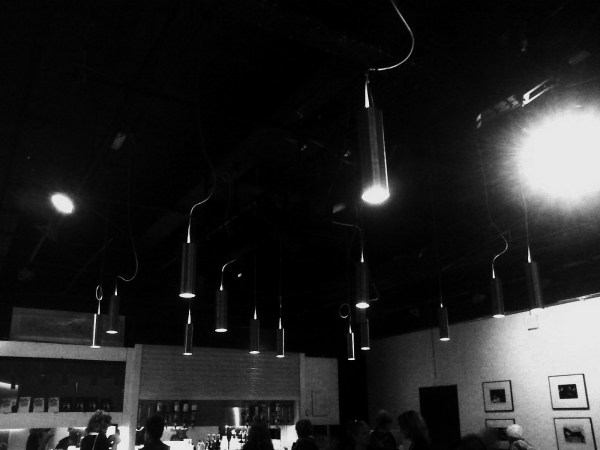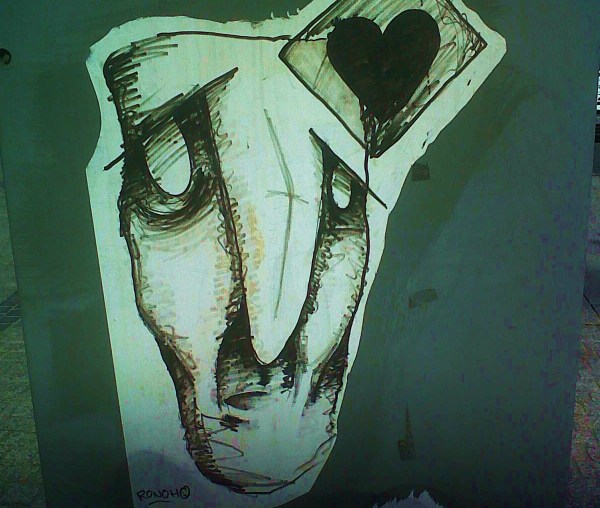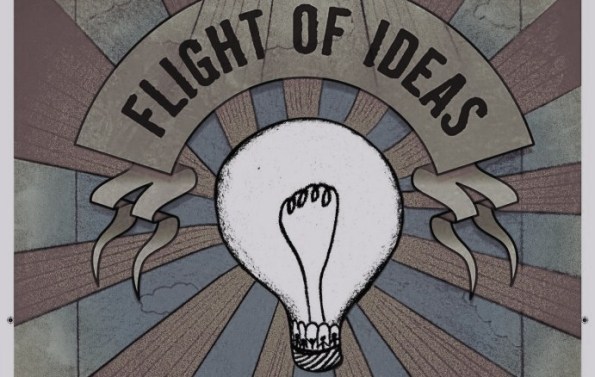Yesterday I saw Postscript in the Civic Theatre. A two woman play about search, and loss, and life.
The two performers Noelle and Bríd were quite lovely to listen to. They were lovely to watch as well, but there wasn’t much to see in this show. The story was told to us, not shown. (It may work quite well as a radio play). They both spoke to us softly and with great sincerity. Noelle addressed us first and she is impossible not to like. I warmed to her immediately. It may be her presence, or the fact that she is telling you intimate details of her life, but I felt almost like I could sit down and have a cup of tea and a chat with her. I don’t often feel that way when I watch a performer onstage. It was an interesting dynamic.
One aspect I would really commend the makers on is the lack of sentimentalisation in the play. The subject matter is a little tough, and at times quite sad, but this is not pushed upon you. The story, told through the reading of letters, is about a woman trying to track down her biological parents. She was adopted at eight weeks, and for years the truth and details about who she is and where she came from have been kept from her. The makers could easily have played on the emotions of this story. There are some really tragic moments and great difficulties in her search. These could have been amped up with over-acting, and music, and great dramatic pauses. But they weren’t. The story was allowed to speak for itself. You could take from it what you wished. I really admire that in any artist. Having the wisdom to recognise the level of true emotion in the story and not highlight it further.
To me a lot of the AV and lighting seemed confusing and sloppy. Maybe there was some odd logic to it that I missed, but if I missed it, then I probably wasn’t the only one. Projections appeared with little thought to timing, lights cut performers at strange angles, light positions aimed to show a change of character or place were mostly lost on me. I saw it the first night in the Civic, so maybe they just needed more tech time.
This play was quite good. It had charm. It was just an hour (I love plays that are one hour.) It was well structured. I was touched by it at times. But it didn’t wow me. It was what it was. Now I am hard to please. I love theatre. But I watch a lot of theatre, and I’d say one play in ten wows me. But equally I couldn’t picture someone who doesn’t attend theatre regularly being wowed by this show either. I felt this play may confirm their reservations about theatre – that it’s grand, that it can be nice, but it’s very talky, and a bit slow, and naturalistic, and aimed at middle aged, middle class, Caucasian women. I can say that the audience I was in – surrounded by middle aged, middle class, Caucasian women – really responded well to it. So maybe that’s good. Your target audience is still happy.
I know a little about clown, I don’t know a lot. Clown is one of those things where every time I learn something new about it, it just makes me realise how much more there is to know.
When I say ‘clown’, I mean the genre, or the tradition of performance, a tradition that dates back centuries, and has a version in every country throughout the world. I do not mean someone who dons a rainbow wig and tries to be funny.
One of the best examples of clown I have seen recently was a show called ALIEN-NATION by Kidding Ensemble.
I will tell you a little of what I loved about this show, and as I do, you might start see why I love clown so much.
The play was about two female clowns in a relationship. It was never clear if this was a friendship or a romantic relationship, but either served the purpose of the show. They had clearly been friends for a very long time. They lived in a teeny tiny flat. We watched them as they carried out their daily lives, all their mundane routines, and interactions. They got in each other’s way, they pissed each other off, they made each other laugh, they sat in silence, they had long chats. It was so perfectly normal. We the audience sat and watched, and we recognised it, and we’d done it, and we’ve been there. Clown is beautiful because clown characters are so perfectly normal. They are the everyman. They have no glory, or power, they are just one of us, dealing with the problems that we deal with.
Clown is amazing to watch because you connect with it so easily. Having lived that same everyday life makes all of the actions so poignant. And good clowns, like the Kidding Ensemble duo, look right at you, and suck you in, and help you to feel that you are with them, that you’re in on the joke too. So you laugh when they laugh, and you cry when they cry, because it might as well be you up there on the stage.
And clowns are magic! Because within this everyday world, within these mundane routines, they see what we don’t see. They see the gags. They see every possible joke they could make. They see how to transform objects and situations right before our eyes.
In this tiny apartment the two clowns cooked dinner. They had a teeny tiny portable kettle, and every evening Angelica Clown would put two tiny baby potatoes into this kettle to boil them. They had one light, a standing lamp. The lamp head faced down to the ground and had a metal grill over the bulb for safety. Every evening Angelica Clown would turn this light up towards the ceiling and place two rashers on this grill to cook them. Marie Clown had a little handbag, with a million pockets, and everything they needed came out of this bag. When they’d leave for work in the morning and head out into the street, Marie Clown would pull two take-away coffee cups out of this bag and they would enjoy their coffee as they walked to work.
During the show alienation builds in their relationship, until one night they become aliens :) Well alien clowns. It’s pretty mental, but hilarious. The show goes on to explore both the idea of alienation in a relationship and the feeling of being ‘alien’ in a foreign country.
The duo teleport themselves around the world, negotiate traffic, watch a tennis match, fall off a waterfall, visit a farm. One of my favourite moments was when they watched the tennis match. They sat facing the audience, tennis match sound effects were played, the duo looked left, then right, then left, almost like a cartoon. They then decided they wanted to learn to play tennis. They each ran and got a toilet plunger. They stood either end of the room. Angelica Clown would push her plunger against the wall or floor, then pull it back, letting it release a brilliant “pop” noise. It sounded just like a tennis ball hitting off a racket. As she did this she would let out dramatic “ugh!” much like the ones real tennis players emit during matches. The invisible “ball” would then soar to the other side of the room, where Marie Clown would push her plunger against the wall to release the sound. They played this way, pushing live tennis match noise back and forth, gradually growing more dramatic as the tension of the match rose. It was amazing. I have never enjoyed a game of “tennis” quite so much.
Another thing I love about clown is how it can simply, and humorously, and without self-righteousness, show us what the world needs. Clowns can show us what we need, and what we need to give to others. The relationship between this duo was beautiful, and difficult. You could see how much they meant to each other, and how much they did for each other, and how much they could hurt each other if they chose to.
There is a moment near the end of the play when Angelica Clown does something incredibly selfless for Marie Clown. I won’t get into the details because I don’t want to give everything away. But that moment was very special. I nearly cried. And that selflessness solved much of their alienation, and brought them back to a lighter, happier place. And the play ended with them and us all laughing our heads off.
Clown, like all good art forms, tells us some difficult things about ourselves. But it then pulls a flower out of its nose, and makes us laugh, and lets us know that it’s ok. It’s all ok. We’re all just learning.
The Civic Theatre in Tallaght runs a programme every year called Tenderfoot. Tenderfoot brings a group of 30 or 40 transition year students together, from various schools, to learn about theatre. Last Thursday I had the joy of visiting the Civic and hearing more from Director Brid Dukes about the programme and its outcomes.
Brid’s excitement about the programme is tangible. She proudly exclaims that Tenderfoot is “absolutely the business.” :)
The programme runs for six months, and works with students from seven different schools in the South Dublin area. Participating schools reflect the geographic and socio-economic landscape of Tallaght and the whole of Dublin 24. In this programme students learn by doing, less academic study and more apprenticeship. It introduces students to the basic conventions of drama, the work of existing playwrights, and the discipline of writing for the stage. The ultimate aim of this programme is for each student to participate in the making of an original play. These plays give artistic voice to young theatre artists.
Brid describes the group, “Forty people who wouldn’t have otherwise met, intermingled, male, female, whatever. All different types of schools.”
The programme promotes gender equity and also tries to reflect cultural diversity as evident in the student population.
Hearing about these transition year students and the work they put into this programme really sparked my interest. Having recently been at a conference in the UK, which focused on youth, and how they can be empowered to strive to contribute to their community and the well-being of humanity, I have been giving a lot of thought to this age group.
The period of youth is brief but experienced by all. A desire to bring about constructive change and a capacity for meaningful work and expression are characteristic of this stage of life. It is at this stage of life that one’s sense of purpose is becoming more clearly defined. One develops habits of mind and spirit that can last your whole life.
Youth can be a period of preparation for life as one studies and considers the future. But it can also be a time of taking on responsibilities, a time when one can leave the attitudes, thoughts and habits of childhood behind and cultivate new capacities.
The Universal House of Justice speaks highly of youth and their capacities, noting their endurance “under arduous conditions, their vitality and vigor, and their ability to adapt themselves to local situations, to meet new challenges, and to impart warmth and enthusiasm…”
If given the opportunity youth can contribute much to their community, and have an articulate voice in the world, even at this early stage of life.
Brid points to Veronica Coburn as being the key to the Tenderfoot programme. She also names Gavin Kostick and Liam Halligan as key players, along with the lighting, the costume, the designers, and the technical staff.
“They’re trained in all of these,” Brid tells me “ But they kind of decide ‘Well I want to do wardrobe, or I want to do some other aspect of it’. But there’s a certain amount of them who want to write… They also act in them. Or could be assistant director. It’s spectacular how it works.”
“These kids would never have been on the stage before. They would never have been in a theatre before. And here they are.”
Brid describes how early on in the process they’re exposed to high quality theatre. “The first thing that happens is after they meet up. They spend the first day here, the whole day. And then they head off into town and go to see a play. Last year they went to The Peacock (theatre). They went to see B for Baby, I think it was. Veronica would pick it very carefully.”
Brid laughs as she explains how heated the discussion about the play gets the following day. “There’s murder… they’re all saying ‘No!’ and ‘Yes!’ It is such fantastic life experience for them.”
The whole process begins in September, and culminates in the students staging multiple plays in the Civic Theatre six months later.
“They’re in here for the month of January, all over the building. And then they put the shows on, for their peers, and it’s open to our regular audience as well. And it’s amazing to see the kids from their class. You might have two kids from one school on the stage, with all the others, and their class is looking at them. And they’re sometimes you know…”, Brid grins as she seems to be recalling some of the students reactions, she continues, “They’re getting better actually…”
Youth have many wonderful powers, and channeling them properly is an important concern. Among these the powers of thought and expression are of particular importance and nurturing them is vital to the expansion of consciousness. There is an intimate connection between language and thought. The power of a thought is revealed through our speech, and developing our powers of expression aid us in understanding our realities.
I believe theatre and the arts are also potent instruments for expression. One can communicate the power of our thoughts not only through speech, but also through all the other aspects that these students are learning – design, lighting, costume, acting, writing. When I asked Brid why one would work in theatre, or help others to work in theatre, her response spoke right to the point.
“It usually has something of relevance to say. It’s something people can actually relate to. Relate to in whatever way they want. Whether that be love it, hate it, whatever. They can communicate with it. I think being involved in it is a very worthwhile pastime, and way of life.”
Brid reflects on the first year they ran the Tenderfoot programme.
“When it started the first year it was just a nightmare. It was so funny. We didn’t have things right. We didn’t have the proper type of rules set out, or –‘This is what you sign up for’. So…they’d be lying on the floor! But we were learning. And it’s really come up. Veronica has written a book now, on how you can do Tenderfoot in your county council area, or city, or anything.”
“We’ve got some lovely feedback. Like one particular girl who was working on costume. And she went to Maynooth to do law or something totally different. And sitting during her first term she thought ‘this is not for me.’ And she went back and did costume design. Fantastic.”
“I mean some of them just vanish. And some of them hang in there. We have this other thing where the Tenderfoot students from past years can become ushers in the Civic, so they get to see all the shows. We specifically use them as ushers in the theatre. And some of them have been trained in on box office. Some of them get other experience. So it’s great.”
Brid reflects on the programme as a whole, “We’re really very proud of all that. It’s my favourite bit.”
(Reference: Ideas and quotes contained in this article are from both the Civic Theatre and the Ruhi Institute.)
Ether Productions just finished its week long run of Landfall, an aerial circus play, in Project Arts Centre. The play is set in a post apocalyptic world where there is no ground. The play had a narrative with four characters learning to work together for a common goal. The story plays out on floating platforms, and on ropes, chains, fabrics and hoops. The narrative wandered along in the first half hour giving each aerialist a moment to perform an enchanting solo sequence on a different apparatus.
Aisling performed the first aerial sequence. Her solo was on the chains. It was rhythmic, and strong, and took my breath away. To me she seemed the most skilled and confident of the aerial performers, and it was easy to get lost in her movements. The character she played was ‘wild girl’, and her chain solo expressed a moving combination of bravery and determination with loneliness and doubt. Niamh used the hoop, Jonathan the silks, and Timmy the rope. When one of them rose up into the air and began to move skilfully through their sequence they were captivating. My mouth fell open as I watched them climb higher, fall lower, swing, spin and twist themselves into shapes most of us wouldn’t manage on flat ground. They were beautiful. I couldn’t take my eyes off them in those moments.
Ether Productions attempted to integrate its aerial circus work into the silent story. This play appeared to me to be very amateur. The four performers were very skilled aerialists. But they had no natural acting talent, and I would be very surprised if any of them has had any actor training. I have also never seen a show where it has been so glaringly obvious that there was no director. It was appallingly clear that no outside eyes had looked at a performance of this show and given notes to the performers. According to the programme one of the four performers, Niamh Creely, was also the creator and director. I expect Niamh may have come up with ideas for the show. I expect she worked hard to facilitate the group. But she did not direct this performance. No one did.
It is hard for me to describe how adversely this bad acting and lack of direction affected the play. The moments of pure confusion were numerous. And the level of condescension to the audience was shocking. But I will attempt to describe two examples.
There was a small prop. It looked black, and maybe silver. It looked as though it may have been some kind of tool. There was a lot of action around this small prop. The gardener had it. The businessman stole it. The opera singer battled with the businessman (who was in love with her, and used every moment of physical violence between them to steal a kiss) to get the small prop back. This small prop was very important. I don’t know what it was. I never found out. To say that this lack of clarity held the story back is a serious understatement.
There was a moment when the gardener and the opera singer were sitting on the back platform. The music changed. There was a different type of noise. The gardener edged to the front of the platform. He sat/lay at the front of it. He reached his arms over the edge – I don’t know why. He held that position for a while, casually reaching downward. The opera singer was pretty distraught about this. She held onto his legs. Then the businessman came over and he also held onto the gardener. They all looked pretty upset about the gardener casually putting his arms over the side. After a while he moved back from the edge. They all gasped in relief. It was at that moment that I realised that I, the audience member, was supposed to understand that something serious and alarming had just happened. I was supposed to understand this from their melodramatic facial expressions. At no point did I feel or think that the gardener was in any danger. I’m still unclear as to what I was meant to be worried about.
The four performers were constantly trying to ‘show’ rather than ‘be’. Every action called attention to the fact that it was an action. The opera singer was not sad, instead she was constantly trying to communicate to the audience “Look, I’m acting sad.” That style of performance is valid and recognised. Bertolt Brecht wrote books on the subject. But Ether Productions was not aiming for that type of a show, these were not deliberate choices.
What was most disappointing was that these four people are not bad performers. They need to work much harder on their acting. But their aerial skills are astounding. There was no need for them to move lethargically around platforms, melodramatically play-acting at misunderstood emotions. All they needed to do was dance in the air. I understood more about each character and believed more about each emotion when they danced than at any other time. They communicated with their bodies. Their hearts connected with our hearts. My absolute favourite part of the show was a duet danced in the hoop by the opera singer and the wild girl. The opera singer mistrusted the wild girl and had no interest in her interactions. The wild girl recognised their differences but was bravely making attempts to befriend her. They danced this small story, full of emotion, in the hoop, suspended in the air. And it was perfect. They didn’t need to say anything. They didn’t need to exaggerate their facial expressions. They didn’t need to mime. We understood. We could feel the dynamics. And we enjoyed it. It was a simple story to which we could relate. And it was an image we rarely get to see. By the end of the duet their friendship was solid, and symbolised adorably with the swapping of sparkly hairpins.
I guess as simple a message as it is, a company really ought to play to its strengths. And no company, especially a relatively new company, should stage an arts council funded show, in a highly sought after venue, having never hired a director.
Robert Wilson was one of the first theatre makers to teach me the word “theatre maker.” He was one of the first to show me a play doesn’t have to have a story. He was one of the first to help me see a show doesn’t require characters. He was one of the first to help me understand that we don’t have to take in dialogue, and understand something on a rational level, for it to communicate something to us. He taught me miles about crossing disciplines, acres about light, and caused me to be forever excited about colour in productions.
We studied Robert Wilson and a production of his called A Letter for Queen Victoria in my first year of college. How he creates, and how he explains his process of creation, had a bigger impact on me than any other writers or theatre makers we learned about in our four years of college. And last week, for the first time ever, I got to watch one of his shows.
That may seem odd. That I have never gone to watch the work of one of my favourite artists. But Robert Wilson has never brought a play to Ireland. (and his web calendar of what productions are touring where/when leaves something to be desired).
So I went to Berlin. To the Berliner Ensemble theatre. And I watched Peter Pan, a joint production between Robert Wilson and CocoRosie.
It was beautiful and clever (and 70% in German), and I’m so glad I went to see it. It wasn’t perfect. It wasn’t the best show I’ve ever seen. But it’s been a long time since my first year in college and I’ve gotten a lot more critical – I don’t think that’s a bad thing. It was magical and dark and strange and beguiling. The sets were so very identifiably Robert Wilson with their stark shapes against a flat intensely coloured background. The lighting was wonderful. I love the way Robert Wilson regards light.
“[I appreciate]…Hollywood portraits of the early 30s and those from Germany in the 20s where light performed as an actor, where every movement, every second was lit and sculptured, allowing us to hear and see more readily and intensely.”
“Light in my work functions as a part of an architectural whole. It is an element which helps us hear and see, which is the primary way we communicate. Without light there is no space”
Robert Wilson interviewed in Dance Ink, 1995.
You can see this attitude at work in all of his productions.
The show was stylised and everything was choreographed. Some of the characters’ hair stood on end for the whole show, standing a good foot into the air. Others had hair sculpted that sparkled green. Wendy’s make-up was such that her eyes looked about five times their normal size. The pirates wore leather. The lost boys wore shimmering satin suits. Some characters were their own odd, but newly interrogated, selves – like the power-hungry paedophilic Captain Hook. Other characters were strange amalgamations created by Robert Wilson himself – like Tigerlily, who was simultaneously the Indian chief and his beautiful daughter.
CocoRosie’s songs were eerie and winding, delving into the absolute despair of Wendy’s parents and dancing through themes of death and afterlife.
The trip to Berlin was worth it, and makes me wonder – what on earth took me so long?
The four dancers breathe. They are standing onstage in the Project Arts Centre. They are facing the audience. On the ground are four very large sheets of newspaper. To their right sit three talented musicians. The four girls, stand, and breathe. The breaths become bigger. The breaths gradually take over their whole bodies. Moment by moment, muscle by muscle the movement changes. The four explorers determinedly walk, into the freezing wind, into the light, into the middle of nowhere. And the audience go with them, into Antarctica.
That’s how it felt to watch Maria Nilsson Waller’s Last Land. I journeyed alongside the group of trailblazers Olofsson, Hedin, Kickham and Nilsson Waller, to Antarctica, through the mountains, through the blizzards, past the animals and creatures, in and around the natives, even barefoot on the frozen terrain. I was with them, every step of the way.
I first saw an excerpt of Last Land in Re-Presenting Ireland in Dublin Dance Festival 2012. It was one of my favourites. So I was thrilled to see the full-length version appear in the Project’s brochure. Having now watched the piece one and a half times, I can safely say, I would go again.
This motif of walking in the blizzard appeared a number of times throughout. Sometimes with all four explorers, sometimes not. Sometimes towards the audience. Sometimes towards upstage right. Sometimes they would look as though they were getting somewhere. Sometimes the motif would change before they made any headway at all. I think what I enjoyed most about that particular movement was that I could feel it myself. I’ve walked into the wind (ok not the Antarctic wind), but I know the general feeling. My body seemed to corporeally relate, without my mind even getting a say in the matter. I also love when any performer makes you see something that isn’t there. There was no wind. There was no snow. They didn’t need to turn their heads away to shield their eyes. But we all saw it, we even felt it. It was also comforting for us spectators to return to a familiar image throughout the show. None of us had been to Antarctica, and many of us had never been to a Maria Nilsson Waller show. We didn’t always know where we were going, where we would be brought to next. So to give us something familiar and recurring eased us, and lent a sense of polish and structure to the piece.
The dancers also made wonderful use of the giant squares of newspaper. At one moment they raised them up into points, forming triangular peaks like mountains in the distance. These peaks then elegantly moved, and created for me an image of icebergs floating in the current. The newspaper was also used for sound. There was a section when the four girls appeared to be creating a blizzard, spinning and running. At this moment they pulled the newspaper through the air with them, creating not only an apt image, but also the cacophonous whooshing of wind and ice circling around them.
However I must address my issue with the false ending. There is a moment when all four girls have dropped to the ground, roll right to the edge of the stage and the light goes almost to black. The only indicator that this is not the end is that there is still music playing, but just barely. If an audience member can tell, from that music, that this show is not over, it is likely that they will still assume they are mere moments from the end. At this point, no matter how much an audience member has been enjoying the show, and would have been happy to watch more, they begin to wrap up their energy and find a resolution within themselves. They think, “I’ll be clapping in a moment, then maybe I’ll get a drink, then maybe I’ll get the luas rather than a bus, yeah I’ll get the luas.” You have lost them. And you will have to work much harder now to win them back. This is what happens in Last Land. The lights come back, the music picks up, the dancers move, the piece continues. But we were ready to go home, so no matter how perfect this choreography is, watching this piece has just become a whole lot more like a chore. I’m sure Nilsson Waller had very good reasons for inserting that peaceful blackout, but I’m not sure it’s worth the sacrifice she makes of the audience’s attention span.
After about 500 of these 800 words being pure gushing praise I probably don’t even need to say this but – go see Last Land. I don’t know when it will next be on. But let’s all keep our eyes and ears open. Send up a flare if you find it. Or, you know, tweet if you spot it in a brochure or something :)
Here is my current theory.
No one says they don’t like music.
This is because there are so many genres of music that you will like at least one of them.
A lot of people say they don’t like theatre.
I believe this is partially because people are not seeing enough genres of theatre. Many people may not be aware of how many types of theatre exist, and how many more kinds are yet to be created.
This blame or responsibility can be put on lots of different shoulders – the public for not giving things a try, the marketers for not being able to sell the right show to the right people, the education system for only teaching Shakespeare and 100-year-old naturalistic dramas… many people can shoulder this.
The theatre makers can certainly shoulder this responsibility. Are we currently making enough kinds of theatre? I feel we are not.
When I look around the Irish theatre scene over the last few years (I can really only comment on the last few years, it’s all I’ve been here for) I see only a few kinds of theatre. I see only a few types of spaces being used, only a few acting techniques being tried, only a few writing and devising processes being developed. It’s grand like, because some of what’s being made is wonderful. And some of what’s being made is not great, but is being learned from.
But there are so many more things to be tried, to be explored, to be acted on, failed miserably in, and tried again.
However even within these few genres of theatre people are organising themselves into unnecessary camps. Each camp believing that it is right. Each camp declaring, and I don’t mean figuratively, I’ve actually heard it, that what their camp makes is real theatre, and what the other camps make is not.
I don’t think this is helpful.
Do, of course, constructively criticize. I am a great believer in constructive criticism. No one’s work is perfect. No play should be put on a pedestal it doesn’t deserve. But don’t tear each other down. Don’t point to other people’s work and call it invalid. I think this is especially harmful to young and emerging theatre makers. They may look like upstarts. Maybe they do try to be too hip. But they are learning. Just like we all should be learning. And to orally trash their work in front of other artists is a real shame.
If established artists could take a leaf out of the emerging artists’ book and try a little more experimentation, and if emerging artists could seek the mentorship of established artists in learning how better to put meaning and purpose behind their work, perhaps Irish theatre would cater more effectively to its audience.
Or if we could realise that where we are now is still only the start of theatre’s journey, that there is still much to achieve, and that by supporting and questioning each other we will likely move forward more successfully, then perhaps we would attract whole new audiences to our stages.
I went to see Silent a couple of weeks ago, in Axis Ballymun. I mentioned that in my last post. In that last post I also told you some of what I had read about Silent. So I’ll do my best not to repeat myself too much in this post.
Silent is a one-man show performed by Pat Kinevane. It has no set, few props, but very effective sound and lighting. Kinevane plays Tino, a homeless man currently living on the streets of Dublin. In this play Tino tells us his story. However this story is not linear, and is not told in chronological order. Like real life, or our own thoughts, it jumps from one thing to the next and back again. There are multiple strands of stories playing out here – Tino in this present moment talking to the audience, Tino on the street accepting money from passers-by, Tino dealing with his mother’s drama and brother’s suicide attempts, Tino falling from the grace of a home-life to alcoholism and loneliness. Kinevane picks up and puts down these strands as needed and weaves them in and around each other.
Kinevane is a talented performer. He interacts well with the audience. He earns our trust and eases the burden of his confessions with well-timed jokes and witty observances. The Axis stage is not small. This night every seat was full. And the play is roughly… 90 minutes. (Was it 90 minutes?) How Kinevane fills that space with that much energy, and sustains it alone, is beyond me.
Kinevane is a very physical performer. He undoes any need for a set by integrating movement into the performance. I am in favour of this. I love physical theatre, and I love when a performer has given proper time and thought to how their character moves. Choreography, small dance sequences, were also integrated in. This too would normally win my favour, and at first it did. However the sequences were repetitive with the same movements being completely overused by the end of the show. Repetition can be used to great effect. But I never felt that this repetition was a choice, or that I was meant to read something from it. Instead it purely felt like the performer, or director had wanted to introduce some dramatic choreography into the piece (as a link to Rudolph Valentino, Tino’s namesake), but did not devote enough time, thought or expertise to it in the development or rehearsal process. I often feel when watching theatre that a show could be further perfected if one were to stand back from the piece, early in the process, and choose one or two ‘experts’ to help strengthen the weaker elements of the play. In this case I feel a choreographer could have been beneficial. Had Kinevane, with his absolute commitment to the incorporation of dance, and his deep knowledge of Tino, collaborated with a choreographer with a broader range of movement, and a good understanding of process, something beautiful could have been created.
I was hit by the heartbreak of this story. I fell with Tino when he fell into desolation. I squirmed when he recounted having been peed on one night on a Dublin street. And I hung on his every word as he described 6pm in the city, with people rushing by, to their warm houses, their quiet calm rooms, and their ability to close the door behind them. And then my heart flicked the switch – it turned off the empathy button. I have a lot of empathy, I feel very deeply for others, at times too deeply to progress in a clear-minded fashion, and so I turn it off. I can follow a sad story, down dark paths, into a low place surrounded by people’s difficulties. But if I am offered no suggestion of remedy to these difficulties, I cannot stay there. Similarly to how to turn down the volume on ads about starving children, and avoid long conversations on the corruption of politicians in this country, I only let this play affect me so far, but no farther. What am I to do with all this feeling? Where do I put it? What do I change? This isn’t a question for Kinevane, or Fishamble, or Axis Ballymun. I am asking this question of myself, and of you, and the arts in general. Arts often tell us sad stories, sometimes they ask questions, but I don’t know how often they offer us answers. Perhaps it is not their job. Perhaps all they need to do is highlight issues. Perhaps it is up to us not to turn that empathy button off, but instead to feel deeply enough to arrive at a conclusion, an idea for a solution. Perhaps art could do that though, give us an idea for an action to take. Or maybe we could come up with that action ourselves. And maybe we’d try the wrong action. Maybe we’d try the wrong action ten times. But maybe on the eleventh time we’d get it right, and make a change.
Silent continues to tour widely. Keep an eye out for dates. Click
I haven’t seen Fishamble’s Silent. But I am going to go see it. There are tickets waiting for me out at the box office in Axis Ballymun. Would you like some tickets to see Silent? I can sort you out. I know a guy.
I have been meaning to see Silent for some time. So I am very glad, that now it’s back from New York, it will be playing in Axis. I can’t tell you anything about it. I will, once I’ve seen it. But for now all I can do is tell you what people have told me – a lot of good stuff.
”He (Pat Kinevance) delves into the mental torture of a man shackled by depression. Examining the travails of Tino McGoldrig, a Cork born man living rough on the streets of Dublin, Silent traces the path of his life to a place of vulnerability and explores how hope and promise evolve into despair.”
– Breda Shannon, Irish Theatre Magazine.
”Silent insists that you pay heed to a homeless Dubliner (Tino) who believes he has become invisible and inaudible… As a “how I got this way” story of madness and homelessness…”
– Ben Brantley, The New York Times.
“Tino remembers his parents’ fondness for the famous silent movie actor Rudolph Valentino, from whom he receives his name. The silent movie aesthetic shrouds Silent, aligning physical movements with sound recollections of conversations, drawing room piano and flamenco rattles. Kinevane’s choreography is flawless here, granting a magic to these ‘silent’ sequences (which are captioned by placards that he holds up, resembling title cards in silent movies) that mystifies the state of his character’s troubled mind.”
– Chris McCormack, Musings In Intermissions.
Doesn’t it sound cool? It also to me sounds somewhat harrowing. But it sounds as though they have found beauty in the pain and torment of the story.
Silent opens at Axis Ballymun on the 10th of October, World Mental Health Day, and continues until the 13th. It runs as part of Axis’s autumn season. If you’d like to hear about what else they have happening this autumn you can click below to view their event guide:
I’m not gonna lie, Axis told me to add that link in there. But they also told me that they’d like to give a pair of free tickets to my readers. Which is pretty nice, given that they don’t know any of us at all :)
They would like to give one reader two tickets to see Silent on opening night, the 10th of October.
Here’s how you enter:
Tweet: Ticket Giveaway
Link: to this page
Mention me: @JessicaCarri9 and Axis: axisBallymun
With hashtags: #events #Dublin
E.g. ” Ticket Giveaway http://bit.ly/SHTBlU @JessicaCarri9 @axisBallymun #events #dublin ”
Competition closes at noon on Friday 5th of October. I will randomly choose a tweet and announce the winner the same day.
Go go go!
[This giveaway is now closed]


